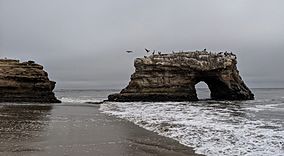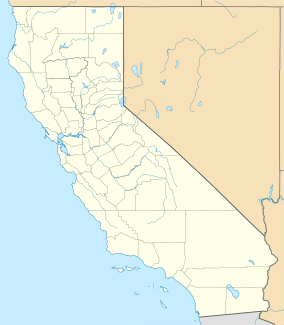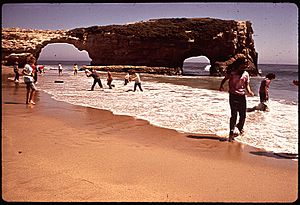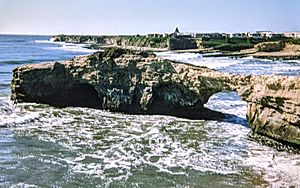Natural Bridges State Beach facts for kids
Quick facts for kids Natural Bridges State Beach |
|
|---|---|
|
IUCN Category III (Natural Monument)
|
|

The last remaining natural bridge provides good refuge for birds
|
|
| Location | Santa Cruz County, California, United States |
| Area | 65 acres (26 ha) |
| Elevation | 0 ft (0 m) |
| Established | 1933 |
| Named for | The natural bridges at Santa Cruz |
| Visitors | 925,000 |
| Governing body | Santa Cruz State Parks |
| Website | Natural Bridges State Beach |
Natural Bridges State Beach is a cool California state park that covers about 65-acre (26 ha) in Santa Cruz, California. It's famous for its amazing natural bridge that stretches across part of the beach. This park is also a super important spot to see thousands of monarch butterflys during their yearly migration. From October to early February, the Monarch Butterfly Natural Preserve can be home to as many as 150,000 monarch butterflies!
Contents
History of Natural Bridges State Beach
The first people to live in the Santa Cruz area were small groups of Native Americans. The Ohlone tribe was a semi-nomadic group. This means they moved around to find food. They hunted animals and marine mammals. They also ate shellfish, fish, roots, shoots, acorns, nuts, and seeds.
The Ohlone people grew plants for medicine. They made tools from local stones and shells. They were also skilled at making beautiful shellfish jewelry and baskets.
Later, the Spanish arrived. Missionaries and soldiers brought the Ohlone people into missions. Sadly, many Native Americans died from European diseases. They had no natural protection against these illnesses.
After the Mexican War of Independence, the area became part of Mexico. Mexican citizens used the land that is now Natural Bridges State Beach for their cattle to graze. Then, after the Mexican–American War, California became part of the United States.
Over the years, the land around the park was used for many things. It was a dairy farm and a brussels sprouts farm. There was also a hotel, housing for mill workers, and even a movie set! The State of California bought the land in 1933. Building the state beach facilities started in 1954. Until the 1970s, the area around the park was mostly wild. Today, the park is surrounded by homes and businesses.
How the Natural Bridges Formed

Natural Bridges State Beach gets its name from the amazing mudstone bridges. These bridges were carved out by the powerful Pacific Ocean. They formed in cliffs that stuck out into the sea.
The arches started forming over a million years ago! Tiny bits of silt, clay, and diatoms (tiny sea creatures) hardened together. This mixture formed the three original arches of the beach. Ocean waves slowly carved out the arches. Then, the waves wore away the cliffs, leaving only islands.
Of the three original arches, only the middle one is left. The arch furthest out fell down in the early 1900s. The arch closest to shore collapsed during a big storm in 1980. The last remaining arch is also slowly wearing away from wind and waves. In the past, visitors could climb, walk, and even drive on the bridges. Now, for safety, the arch is closed to people.
Wildlife and Nature at the Park
Natural Bridges State Beach is a special place for many animals and plants.
Monarch Butterfly Migration
The park has a eucalyptus grove that is a perfect home for monarch butterflies. Up to 150,000 butterflies fly as far as 2,000 miles (3,200 km) to reach the park. They come here to escape the cold winter weather in the northwestern United States and Canada. The city of Santa Cruz even has a festival every year to celebrate the butterflies' return!
Monarchs gather in groves along the coasts of California and Baja California. At Natural Bridges State Beach, they find shelter from the wind. They also find water and food. The butterflies gather closely on the trees. They link their legs together, looking like a big clump of leaves. By clustering together, the butterflies protect each other from cold winter winds and rain.
In the late 1990s, the number of butterflies at the park started to go down. Scientists think this happened because there weren't enough pine and eucalyptus trees. However, as numbers dropped here, more butterflies started going to nearby Lighthouse Field State Beach.
Different Habitats
The 65-acre (26 ha) of the park have many different kinds of natural areas, called habitats.
- Saltwater and freshwater marshes are found along Moore Creek.
- Coastal Scrub plants grow around the edges and in undeveloped parts of the park.
- You can also find sand dunes and a freshwater pond at the park.
Marine Life and Birds
The tide pools at the beach are like small windows into ocean life. When the tide goes out, you can see many creatures. These include urchins, sea stars, hermit crabs, and kelp.
From the beach, you might even spot larger marine mammals. Look for whales, seals, and sea otters swimming in the ocean. The park, with Moore Creek's mouth, is also a great home for many bird species. You can see shorebirds, gulls, and snowy egrets. Brown pelicans and cormorants often rest on the last natural bridge.
Just off the coast is the Natural Bridges State Marine Reserve. This is like an underwater park. It helps protect ocean wildlife and the amazing ecosystems found there.
Fun Things to Do at the Park
Natural Bridges State Beach is open all year for fun activities!
- You can go swimming in the ocean.
- It's a popular spot for surfing, especially in winter when the waves are big.
- There are great trails for hiking and nature walks.
- It's a perfect place for picnics.
- The beach is small and protected.
- In the afternoons, the winds are great for kite flying and wind surfing.
You can hike trails through the Moore Creek estuary and the Monarch Butterfly Nature Preserve. During fall and winter, guided tours of the butterfly preserve happen on weekends. Tours of the tidal pools and nature walks are offered all year long.
Nearby State Parks to Explore
If you're looking for more outdoor adventures, check out these state parks nearby:





